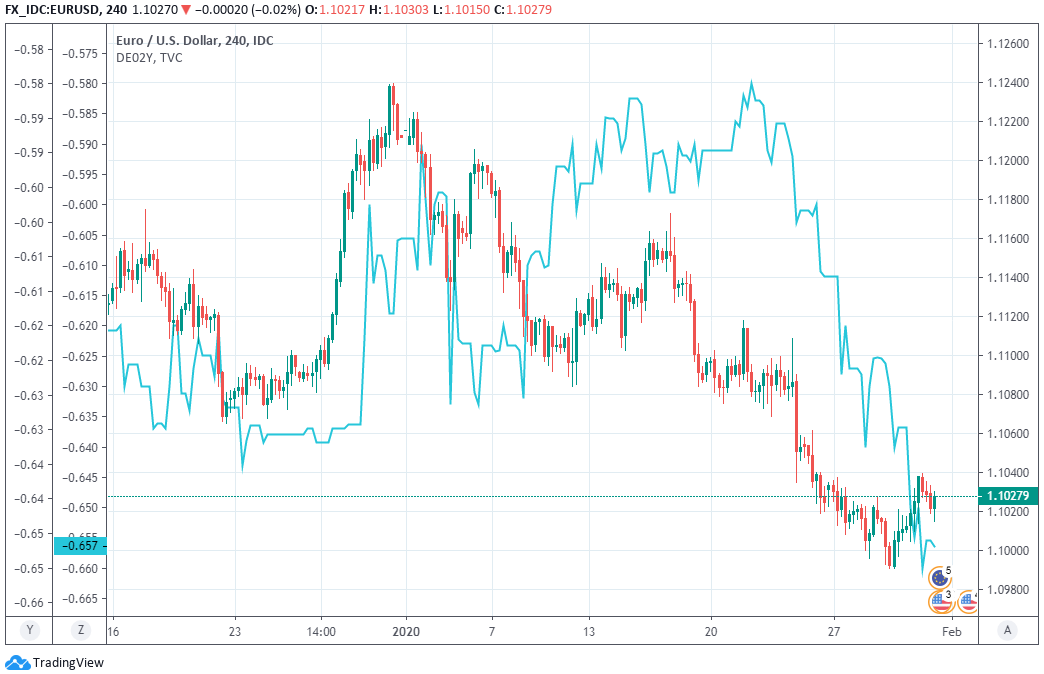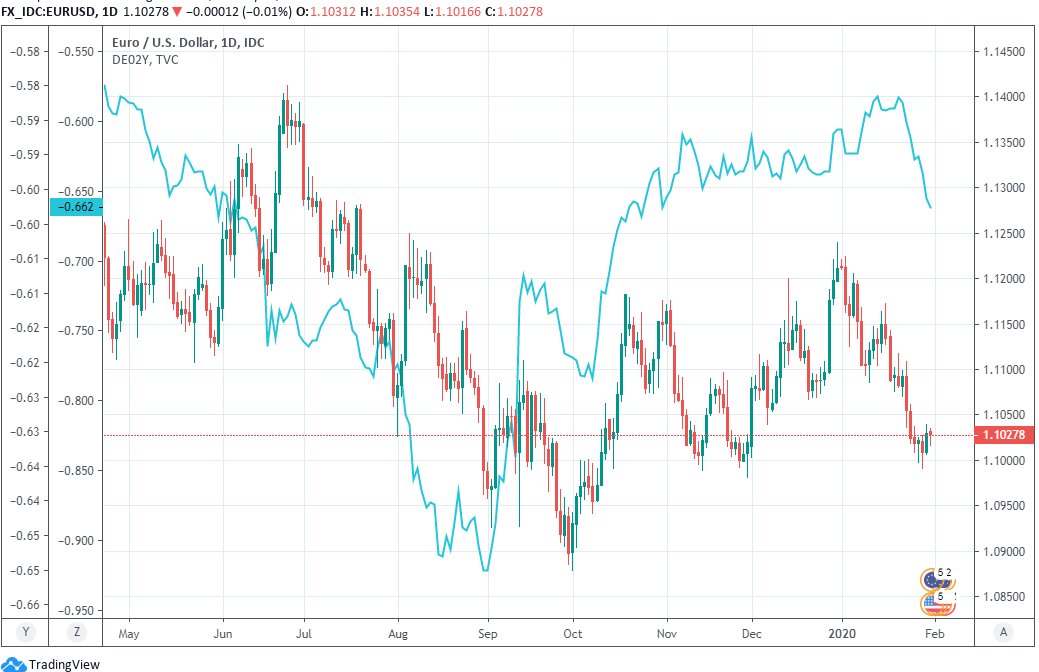Euro-Dollar Leans on 1.10 Support, Weighed Down by Disappointing Economic Data
- Written by: James Skinner
- EUR/USD's post-October range intact but under threat.
- EUR headed back for another test of support below 1.10.
- As fresh signs of Eurozone-U.S. divergence set to weigh.
- French economy contracts in Q4 as German sales slump.
- U.S. economy beats expectations with steady growth in Q4.

Image © Adobe Images
- EUR/USD Spot rate: 1.1000, down 0.01% today.
- Indicative bank rates for transfers: 1.0643-1.0720
- Transfer specialist indicative rates: 1.0864-1.0930 >> Get your quote now
The Euro-to-Dollar exchange rate's narrow multi-month range remains intact but the single currency is increasingly at risk of another test of its lower boundary as fresh signs of economic divergence between the Eurozone and U.S. weigh in a risk-off market that's riddled with coronovirus concerns.
Europe's single currency has largely traded between 1.10 and 1.12 since early October despite having dipped a toe in the waters above and below the two thresholds on a handful of occassions. However, some technical analysts say the threat of a breakout to the downside is now growing.
"Prices are hovering over 1.0980 pivot support. A decline through there would suggest the gains from last year’s 1.0880 low has merely been another correction and we eventually retest that support area again (a broad range is still possible first). Otherwise, while over 1.0980, a recovery through 1.1055-1.1090 resistance is needed to alleviate downside risks," says Robin Wilkin, a cross asset strategist at Lloyds Commercial Banking.

Above: Euro-to-Dollar rate shown at 4-hour intervals, alongside 2-year German government bond yield (blue line, left axis).
A factor that's sustained a steady appreciation of the Dollar against the Euro has been the outperformance of the U.S. economy over a struggling Eurozone. The Eurozone economy grew by just 0.1% on a quarter-on-quarter basis at the end of 2020, according to Eurostat on Friday, with annual GDP coming in at 1.0%.
Italian GDP growth was -0.3% for the final quarter and French GDP was -0.1%, while Spanish GDP came in at a more respectable 0.5%.
Meanwhile, the Dollar was still buoyed by U.S. GDP figures released in the prior session, which showed the economy motoring along at an unchanged 2.1% annualised pace when some in the market anticipated a slowdown, making for a stark growth divergence between the U.S. and Eurozone economies.
"We don’t get any details in this advance report, but the separate country data reveal a huge divergence in the underlying stories. In France, growth was stung by a slide in inventories, without which GDP would have risen by 0.3% q/q; instead it fell by 0.1%. In Spain, however, domestic demand fell off a cliff, but the economy still managed a solid 0.5% q/q expansion due to a leap in net exports," says Claus Vistesen, chief Eurozone economist at Pantheon Macroeconomics.

Above: Euro-to-Dollar rate shown at daily intervals, alongside 2-year German government bond yield (blue line, left axis).
"The economy looks like being a supportive factor for President Trump’s re-election in November but 2021 and beyond looks more uncertain. Some of the details in the Q4 report highlight underlying weakness," says Derek Halpenny, head of research, global markets EMEA and international securities at MUFG. "We see support building around the 1.1000 level in EUR/USD."
GDP fell in France alongside business investment, consumer spending and manufacturing output. December retail sales surprised on the downside with a -3.3% contraction in Germany, when markets looked for only a 0.5% fall. However, and given Friday's Eurozone number is simply a "preliminary estimate", there's currently very little detail available on what drove the slowdown at the continental level.
"We can confirm that two patients in England, who are members of the same family, have tested positive for coronavirus. The patients are receiving specialist NHS care, and we are using tried and tested infection control procedures to prevent further spread of the virus," says Chris Whitty, Chief Medical Officer.
The Dollar was higher against most of its rivals after benefitting from market unease over the international spread of China's new coronavirus, which was confirmed to have reached the UK on Friday with two intrafamily cases reported. The virus has threatened to bring China's economy to a near-standstill this week but is now in 20 countries including France and Germany, leading the World Health Organization to declare an international emergency on Thursday.
"The market is proving slow to recognize the risks of a dramatic downgrade to global growth this year as a consequence of the coronavirus outbreak and its effects on global supply chains and consumer activity, even as well all hope for a minimum toll on human life," says Steen Jakobsen, chief economist at Saxo Bank. "Expect significant repricing of short-term policy rates (read: the Fed) down to protect yield curve steepness. By the end of February, as much as 100 basis points lower global growth should be fully priced and companies will submit much lower guidance on this disruption (Apple started yesterday)."




